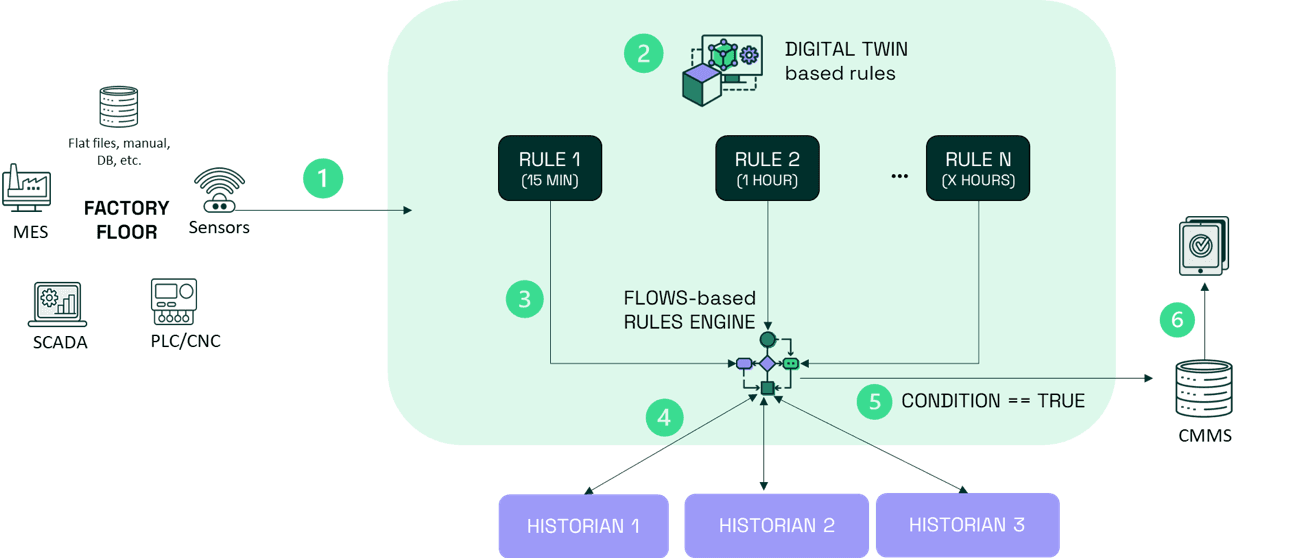Vishvesh Shah
Director of Product Management
The integration of edge computing with digital twins can help address challenges faced by manufacturers. It can reduce response time, optimize data, improve security, and lower risk.
A large manufacturing company created an automated work order based on live monitoring of asset conditions, powered by Litmus Edge – in just a single day.

A large manufacturing company created an automated work order based on live monitoring of asset conditions, powered by Litmus Edge – in just a single day.
The manufacturer had their entire asset monitoring system (for hundreds of assets) built on a soon-to-be-retired component that periodically queried only a single type of database. This meant slow development times (12 months!), limited scalability, and a blind spot for valuable data. Change was imminent.
They adopted Litmus Edge to replace clunky code with rules, built using our intuitive no-code interface. Today, each rule seamlessly connects to multiple data sources, regardless of their type, extracting insights and triggering work orders in the customer’s CMMS system via a REST API.
The manufacturing company used the following Litmus Edge features to build their solution:
Digital Twins
Flows
Historian and Database Integration
CMMS Integration

The manufacturer used Litmus Edge’ prebuilt connectors and integrations to bring in data from every kind of database and/or historian on their plant floor.
Once the data was inside the platform, they leveraged the Digital Twins feature to create specific rules. Each rule contains the following: Well-defined parameters to query the historian or database. The regular expression to compare the query findings for a match. Every single rule interacts with the rule engine, built using Flows – another feature in the same Litmus Edge platform.
The Rules Engine supports multiple historians and databases, each of those being of different types.
Based on the rule, when a match is found, the rules engine triggers a REST API call to the manufacturer’s CMMS system.
The CMMS can generate an automated work order in their system.
Replicating this process is as simple as creating a new Digital Twin with the required parameters. Templates allow this process, including the creation of Digital Twins and Flows-based rule engine to be repeated easily across other plants and sites.
This Litmus Edge solution was up and running in just one day!
No more data silos.
By seamlessly integrating with multiple types of data sources, the manufacturing company was able to harmonize their data streams into actionable insights. Pre-defined rules act as automated conductors, triggering REST API workorder creation with precision and speed, preventing issues before they escalate.
Scalability on steroids.
This solution reduced what took a year with legacy methods and tools to just a single day – not only solving the challenge at hand but opening doors to more data intelligence applications right where the data is generated – at the edge.
Efficiency amplified.
By proactively identifying all contributing data trends and automating workorders, the manufacturing company can minimize downtimes, reduce maintenance costs, and optimize assets for peak performance.
Ask for a demo to see how Litmus Edge could help you with your OT data challenge.
Dave McMorran
Director of Sales Engineering
Dave McMorran heads the Sales Engineering team at Litmus.
Vishvesh Shah
Director of Product Management
The integration of edge computing with digital twins can help address challenges faced by manufacturers. It can reduce response time, optimize data, improve security, and lower risk.
Suranjeeta Choudhury
Director Product Marketing and Industry Relations
Edge computing moves computing power closer to data sources. It has 3 aspects: consumer, enterprise, and industrial IoT edge. An industrial edge DataOps platform provides real-time insights, analytics, and remote monitoring for industrial settings.
Dave McMorran
Director of Sales Engineering
In manufacturing, embracing digital transformation is crucial. Litmus Edge simplifies the Unified Namespace (UNS) architecture, making it seamless to transition to digital and thrive in the modern landscape.